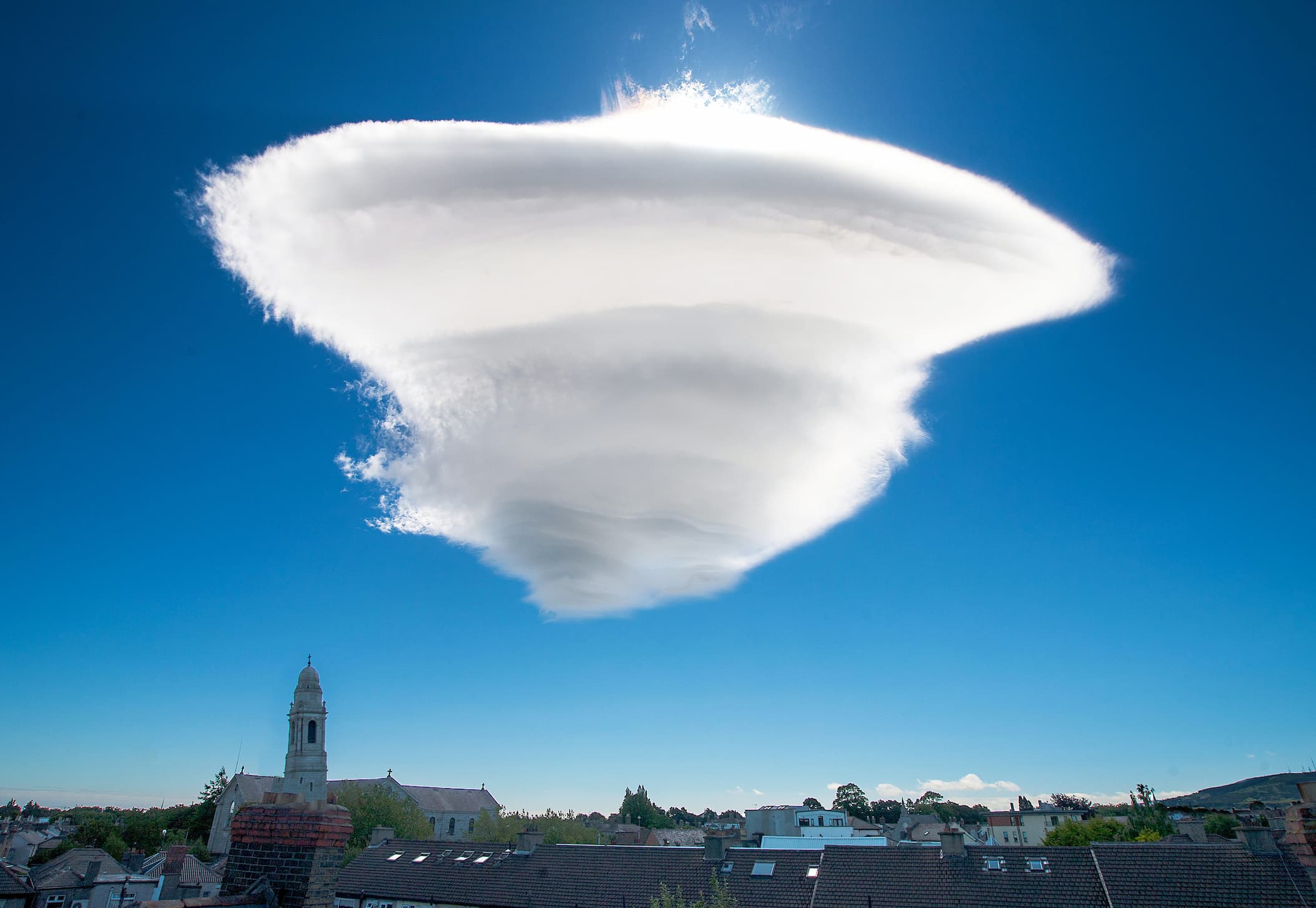Clouds can move at different speeds, typically between 20 and 40 miles per hour (32–64 km), but sometimes as slow as 1 mile per hour or as fast as 120 miles per hour. Many factors influence how fast clouds move. For instance, fluffy cumulus clouds can go up to 15 miles per hour, while wispy cirrus clouds can move along at over 100 miles per hour.
- How Do You Find the Speed of Clouds?
- Types of Clouds by Their Movement Speed
- What Determines How Fast Do Clouds Move?
- Why Do Clouds Appear to Move at Different Speeds?
- How Far Do Clouds Travel?
- How Does Temperature Affect Cloud Speed?
- How Does Humidity Affect the Speed of Clouds?
- How Do Clouds Move?
- The Most Common Clouds
How Do You Find the Speed of Clouds?
To estimate a cloud’s speed, we need to know its size. You can do this by comparing how wide it looks from the bottom to how high it is. But there’s a trick to it. First, you have to guess how far you can see in the sky. If you’re down on the street, it’s like looking at a half-sphere with a radius of 2 to 3 miles. But if you’re up in a tall building, it’s a bit different.
Once you have an idea of how far you can see, you watch the cloud and time how long it takes to move across a certain part of the sky. This helps you figure out how fast it’s going. It can be tough to judge angles accurately, especially when things are really high or almost right above you. So, for certain clouds that are way up there, like cirrus clouds, you might have to adjust your estimate because they move a longer distance for the same angle change.
Types of Clouds by Their Movement Speed

The average wind direction is where a cloud will move. Knowing the speed of the wind at a certain location and altitude will get you quite close to the cloud’s actual speed. Thus, the height and general shape of each kind of cloud determine its speed. Some types of clouds are listed below based on their speeds:
High-level:
- Cirrus clouds: Clouds that are 100% ice crystals are called cirrus clouds, and they move at rates of up to 100 miles per hour.
Mid-level:
- Altostratus clouds: These flat and uniform clouds in the mid-levels suggest a warm front is approaching, culminating in rain or snow. They can move at 50 miles per hour.
Low-level:
- Stratus clouds: They are low-lying clouds that are uniform in appearance and cover the sky entirely. They usually move at 20–30 miles per hour.
- Stratocumulus clouds: They are typically low and have a bumpy appearance, whether they form in patches or as a continuous sheet. These clouds tend to travel at speeds of 20 to 30 miles per hour.
Multi-level:
- Cumulus clouds: Clumpy cumulus clouds develop at any altitude and move at rates of 15 to 20 mph.
- Cumulonimbus clouds: Thunderstorms are sometimes born within these thick, dark clouds. A speed of up to 60 mph has been recorded for these clouds.
- Nimbostratus clouds: Continuous precipitation and speeds of 15 to 20 mph are typical for nimbostratus clouds.
— The reason wind causes clouds to travel more quickly
- Clouds consist of tiny water particles, like condensed droplets and ice, that remain suspended in the air due to their small size. The wind carries these particles, and their movement is directly related to wind speed.
What Determines How Fast Do Clouds Move?
Usually, clouds travel between 30 and 120 miles per hour (50 and 200 km per hour). However, the speed can change depending on what the clouds are made of and how fast the wind is blowing. For instance, storm clouds can move quickly, while fine, clear-weather clouds tend to move slowly.
- Altitude: At higher altitudes, clouds experience a variety of wind conditions. They move more swiftly at higher elevations because the winds are stronger there.
- Atmospheric Pressure: A change in atmospheric pressure could cause an air current to carry clouds along. Since high temperatures are the cause of low air pressure, winds are stronger in low-pressure areas close to high-pressure areas.
- Earth’s Spinning: Because of the Earth’s spinning, the direction and speed of the wind impact the movement and speed of clouds, even at high altitudes. However, since clouds grow inside the Earth’s atmosphere, the planet’s rotation has no direct effect on their speed.
- Air Currents: When the sun heats up the upper atmosphere, the air goes up, while the colder, heavier air near the planet’s surface comes down. The way the wind flows, like which way it goes and how fast, also affects how fast clouds move.
Since the wind carries clouds, stronger winds result in faster cloud movement.
Why Do Clouds Appear to Move at Different Speeds?
The air in a cloud determines how fast it moves; in jet streams, cloud speeds may exceed 185 miles per hour. The distance between us and the cloud also affects our sense of its speed. This optical illusion might make low cumulus clouds seem to move faster than high cirrus clouds. Clouds are nebulous and hard to gauge in distance, but clouds higher up in the sky tend to move faster than lower ones. Because the wind is usually stronger up there.
Wind, convection, and particle size all influence cloud particle movement. The wind determines their direction, with upper tropospheric clouds often moving faster. Convection and particle size affect the vertical movement of the clouds and their likelihood of speed. Different cloud types are associated with varying particle sizes.
The wind is often strongest in the upper troposphere.
Altitude affects wind speed through the “atmospheric pressure gradient”. As you ascend in the atmosphere, air pressure decreases, creating a pressure gradient that generates wind and makes clouds move faster. Greater pressure differences result in stronger winds as air moves from high-pressure to low-pressure areas.

How Far Do Clouds Travel?
Strong winds may carry clouds across continents, yet weaker winds can keep them in one location. Some types of clouds, when combined with the right conditions and winds, travel hundreds of miles away. Depending on the velocity of the wind, clouds can travel at speeds of 30 mph to 100 mph or even 250 mph!
The speed and direction of the wind can change a cloud’s movement, making it travel varying distances. Additionally, the size of a cloud can affect how far it goes. Smaller clouds tend to move quicker than bigger ones. On an ordinary day, a typical cloud might travel approximately 110 miles (180 km).
What really matters here is how high the cloud formed. When clouds form 12,000 feet up, they move at 25 miles per hour, but if they form at 5,000 feet, they go a bit slower, at 18 miles per hour.
— But how long do clouds stay in the air?
- Commonly seen fluffy cumulus clouds usually stick around for about 15 minutes to a couple of hours. Stratus clouds, on the other hand, can hang around for days. The distance these clouds travel depends on their type. The amount of moisture in the air also plays a role in how long a cloud lasts. When it’s not very humid, the liquid air molecules disappear quickly, and the cloud doesn’t last as long.
How Does Temperature Affect Cloud Speed?
Clouds’ ability to develop and their chemical make-up are both influenced by the ambient air temperature. Clouds are made up of many water droplets, ice crystals, or sometimes both. They may float for a long period in the air because of their small size and high air resistance, especially if they stay in rising air currents.
In undisturbed air, a typical small cloud droplet falls at a consistent speed of approximately 0.50 inches per second (equivalent to roughly 1.3 cm). These droplets are so incredibly small that they can remain in liquid form even when the temperature drops as low as -22°F (-30°C). When this occurs, we refer to them as supercooled droplets.
The way air molecules move depends on how hot or cold it is around them, and this, in turn, affects how the wind blows, how strong it is, and where it’s headed. How quickly they move depends on how fast the wind is blowing.
Radiation is primarily responsible for determining the temperature of molecular clouds. How fast these clouds rotate depends on the difference in temperature between their lowest and highest parts. When there’s a big temperature difference, it creates a strong pressure difference, which in turn makes the winds stronger and the clouds move faster.
How Does Humidity Affect the Speed of Clouds?
Clouds can’t form without enough humidity. Water vapor in supersaturated air tries to find cooler places to condense. The first is the gradual growth in size and volume of cloud droplets as water vapor continues to condense into them. If the air is saturated, fog will form near the ground, while clouds will form in the atmosphere.
There is a relationship between cloud speed and cloud humidity. Higher humidity levels can lead to slower cloud movement, as moist air is less dense and offers less resistance to the traveling clouds. Conversely, lower humidity levels tend to result in faster cloud movement, as drier air is denser and can more readily push clouds along.
How Do Clouds Move?
The movement of clouds and their subsequent speed is a result of the air currents in the atmosphere. These elements affect how the clouds move:
Wind: Wind drives cloud movement across the atmosphere, from ground level to high altitudes, even beyond jumbo jet flight limits. While there may be no wind at ground level, when you gaze higher up, you can still see clouds moving from the wind.
Air currents: Air currents have a significant impact on the movement of clouds. Clouds are formed as air rises and expands, causing it to cool. As their buoyancy rises in comparison to the surrounding air, the cloud can rise even higher. These packets can be seen rising steadily in cumulus clouds.
Weather patterns: Clouds’ directions and speeds vary depending on weather conditions, such as high- or low-pressure systems that direct the wind and the clouds.
Type of cloud: Some clouds, like the cumulus, are stationary and associated with pleasant weather, while others, like the cirrus, are flimsy and may move greater distances.
The Most Common Clouds
- Cirrocumulus
- Cirrostratus
- Cirrus
- Cumulonimbus
- Cumulus
- Nimbostratus
- Stratocumulus
- Stratus
References
- Air & Water | Understanding Climate – Ocean Surface Topography from Space (nasa.gov)
- CLOUD DEVELOPMENT (weather.gov)
- Clouds and How They Form | Center for Science Education (ucar.edu)




